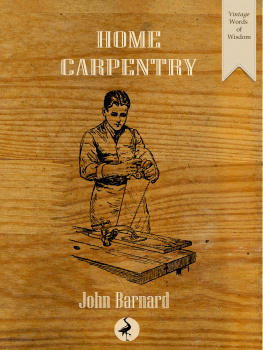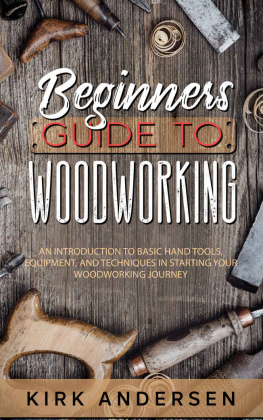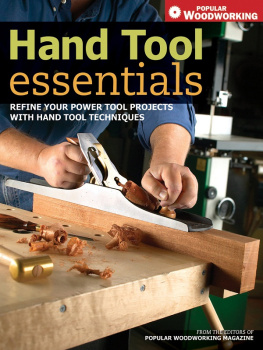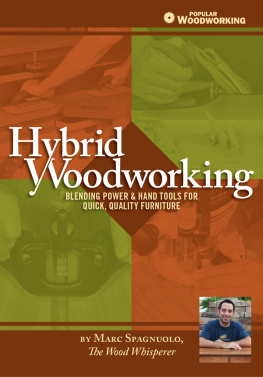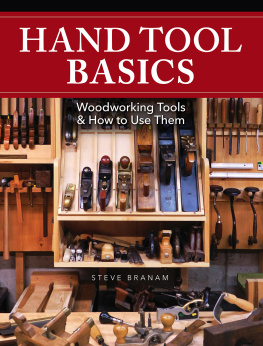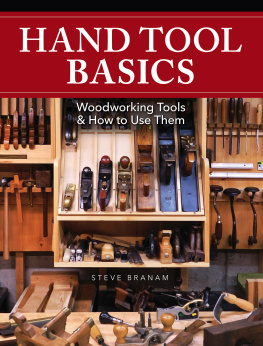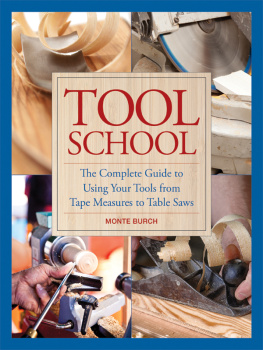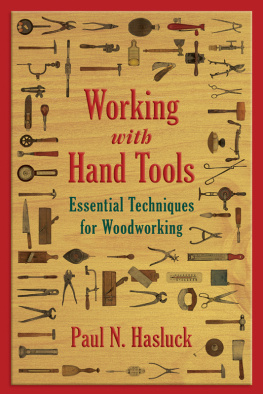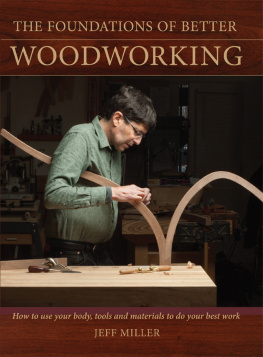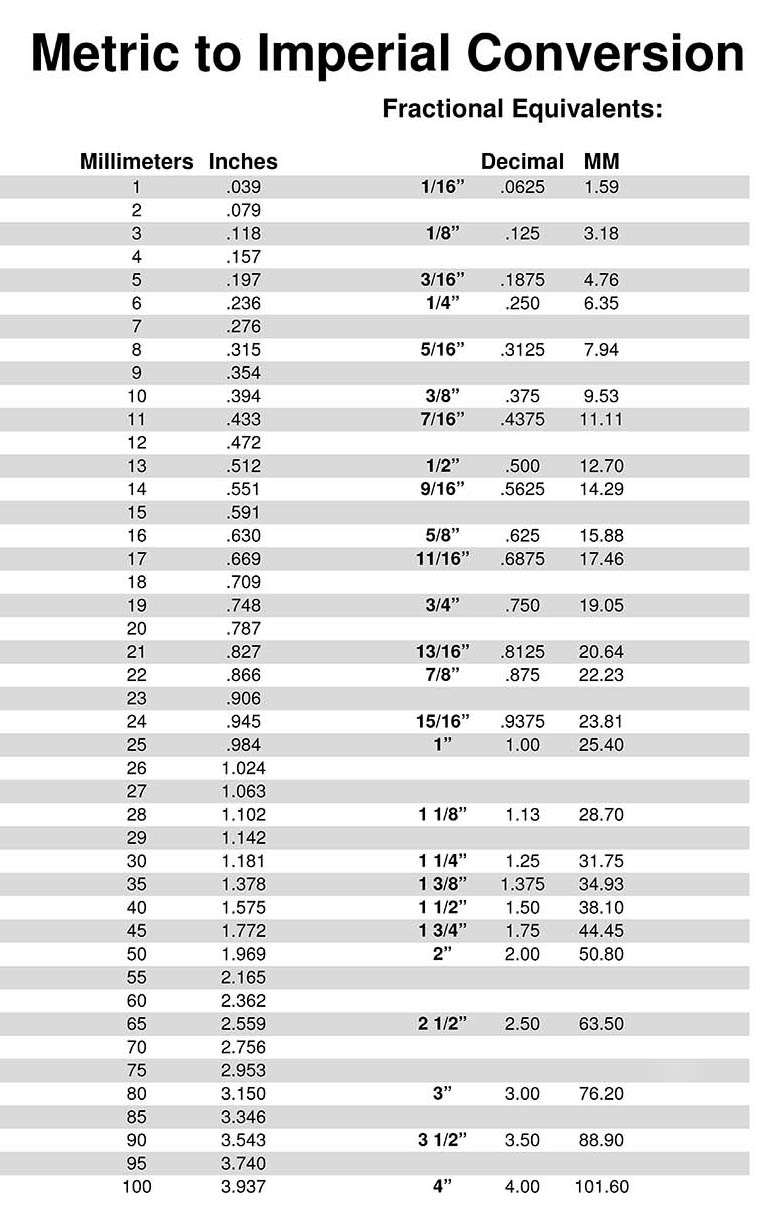PUBLISHERS FOREWORD
All woodworkers know that tools appropriate for the job in hand improve the quality of the work and render the process easier and more enjoyable.
This Vintage Words of Wisdom title, published in 1925, provides a comprehensive guide to hand tools for the keen woodworker. In addition the author provides advice and guidance as to the best use of each tool to ensure both efficiency and effectiveness. Many of these tools have remained largely unchanged for centuries but it can be argued that their development reached its zenith during the late-Victorian age. This was when production techniques and a better understanding of materials combined to enable the mass production of high quality, durable tools to a consistent standard.
In the late twentieth century the main change for the amateur woodworker has been the introduction of numerous power tools. Obviously this volume pre-dates the many drills, sanders, saws and cutters that have become a common feature of the modern workshop. Nonetheless the fundamentals outlined in Woodwork Tools and How to Use Them remain as relevant now as they were almost a century ago and there is much sound advice for the woodworker and hobbyist of today. Also, of course, some of us have inherited tools from fathers and grandfathers, or have picked up vintage tools from market stalls. There is a certain pleasure and satisfaction from using and caring for family heirlooms or tried and tested vintage tools that were made to last.
Some of the techniques present a potentially satisfying challenge such as setting and sharpening a saw or drill bit. Others offer good, plain common sense in how to make the best use of each tool. The language used may sometimes be quaint but this adds rather than distracts. For example when using the plane the author suggests:
To the beginner, we would say: stand at the side of your bench in exactly the same position as though you were going to lead off in a boxing bout; then drop the hands, grasp the plane and proceed to use it.
This is not the sort of advice one expects to find in the typical modern workshop manual!
A further characteristic of this book is the idea of self-sufficiency making your own plumb line, grinding and sharpening the blade of your plane. Concepts accepted by our forefathers but the easy availability of replacement blades and bits has made us more inclined simply to buy a new one.
The text is supported by a wealth of detailed drawings that illustrate clearly all the tools, their use and maintitalics Woodwork Tools and How to Use Them offers wisdom from the past that remains just as relevant today and should enhance the enjoyment that any woodworker gets from their hobby.
The Metric to Imperial Conversion Chart in this book has been included with the kind permission of Eric Meier of the Wood Database www.wood-database.com
VINTAGE WORDS OF WISDOM
The Vintage Words of Wisdom titles are not simply facsimiles of old books. They have been carefully selected and professionally produced as high quality ebooks. Our aim is to make the best vintage books on popular topics of interest more widely available again. The books range from practical titles that include wisdom from times past to unashamedly nostalgic works that will appeal to those who may remember these or similar titles from their childhood. Often amusing and quaint, these vintage volumes also contain wise words and advice that may have been forgotten in the intervening years. So often it is worth revisiting the past to remind ourselves that the best ideas stand the test of time. Above all, the Vintage Words of Wisdom titles are highly entertaining and provide a fascinating snapshot of life in days gone by. We have chosen books with wonderful illustrations, exciting stories of daring and adventure, practical advice and charming nostalgic descriptions of a simpler life.
Titles include:
Poultry-keeping
Room and Window Gardening
Ferns and Fern Culture
Woodwork Tools and How to Use Them
Home Carpentry: A Practical Guide for the Amateur
The Boys Book of Aeroplanes
The Railway Age
Sky Roads of the World
Lillie Londons Needlework Book
The Cottage Farm Month by Month
For further details and the most up-to-date information on our titles please visit our website www.wordstothewise.co.uk
AUTHORS FOREWORD
It has been said that success in life is due chiefly to the gift of knowing how to make use of ones opportunities. Certainly, in a not unimportant walk of life, success in woodwork is due, not so much to the quality of our tools, as to knowing exactly how the tools we possess should be used. To most of us the use of a saw or a plane or a chisel is obvious. We know what each can do and we have seen each do it. But to know just how to handle and manipulate the saw or the plane or the chisel to effect the desired result with a minimum of effort and without injury to either tool or material that is knowledge worth having, and the earlier it is acquired the better.
The aim of the volume is twofold. In the first place it is designed to meet the needs of the home worker who, in his evening task, has seldom the opportunity of getting helpful advice from an expert, and to whom the suggestions offered may be of valuable assistance. In the second place it should appeal to those engaged in cabinet-making, joinery, carpentry, wood-turning, pattern making and other trades who, although possessing a slight knowledge of larger tools, may lack actual experience in their uses. It is hoped, too, that to teachers and students in Technical Schools the volume may be of practical aid.
The many illustrations in the book are the work of the Author (Mr. William Fairham) and Mr. Edgar Newton.
J. C. S. BROUGH
THE SAW
RIP SAW HAND SAW PANEL SAW SELECTING SAWS THE SET OF A SAW
O N receiving boards from the saw mill or timber merchant, the worker will have to convert his timber to suitable sizes for the particular work he may have in hand, and for this purpose he will require a rip saw or a hand saw.
Rip Saw Fig. 1 is an illustration of a hollow backed, taper ground rip saw with a close-up pattern handle. This type of saw is for cutting in the direction of the grain, and is made in the following sizes so as to suit various workers, 20 ins., 22 ins., 24 ins., 26 ins. and 28 ins. Taking the average height of a worker at 5ft. 6 ins., a 26 in. rip saw will be of convenient size for all general purposes.
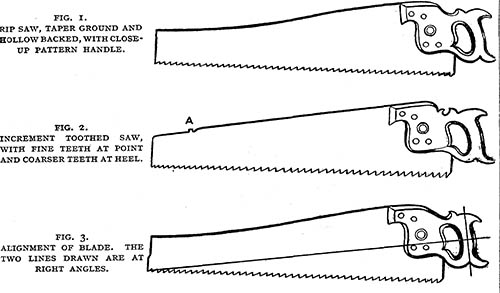
The rip saw as usually stocked by the various tool shops has all its teeth of the same size; and, whilst this type of saw answers admirably for every-day work, the buyer or user should have his attention drawn to the increment toothed saw (Fig. 2). This type of saw has fine teeth at the point to commence the cut, and coarser teeth at the heel of the saw to finish the cut. Beginning the cut with fine teeth gives a smooth cut; but, these fine teeth soon become clogged up with sawdust, and to some extent they lose their efficiency. As this partial clogging up of the saw gullet would become troublesome, the size of the teeth is gradually increased, thus bringing the larger teeth into action just when they are needed.


